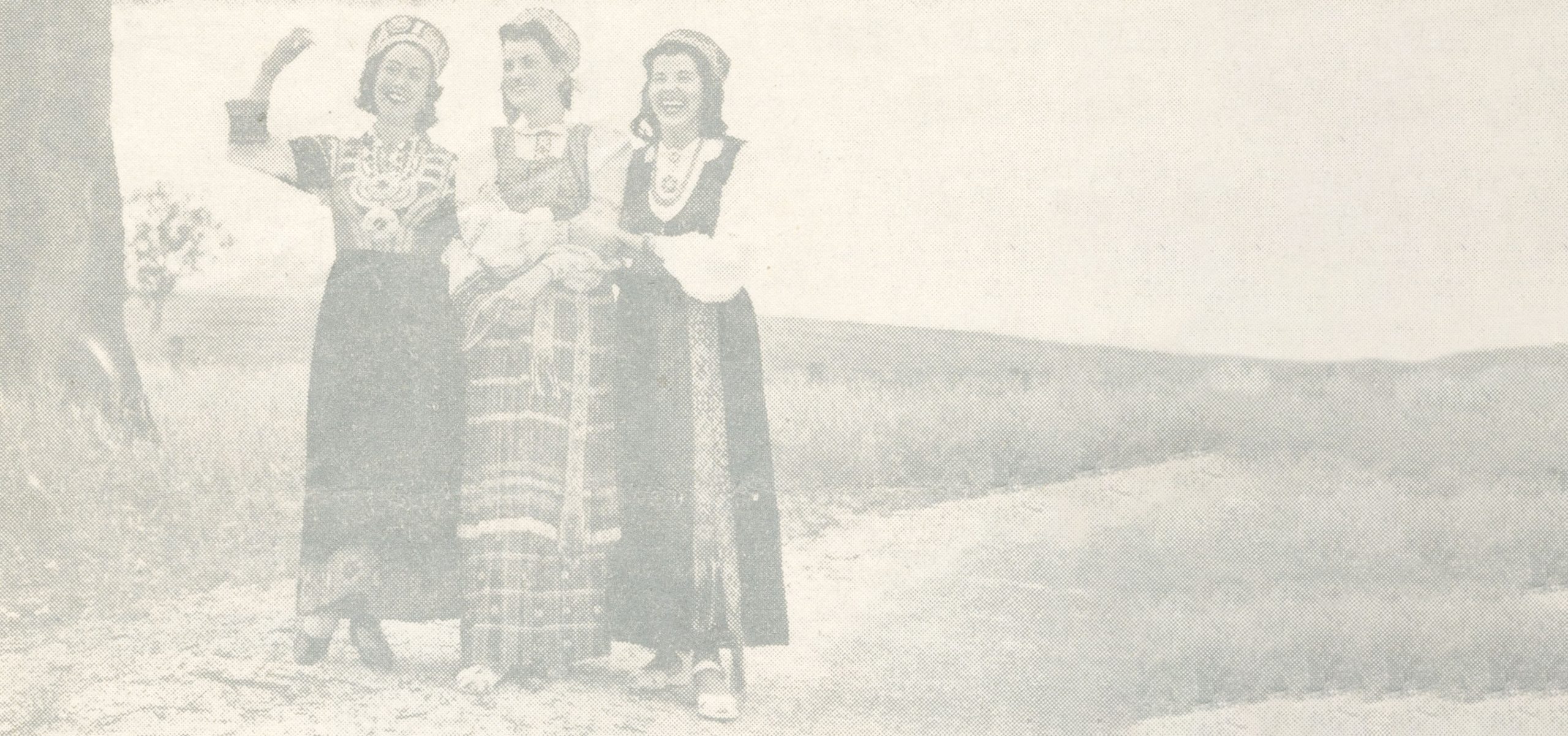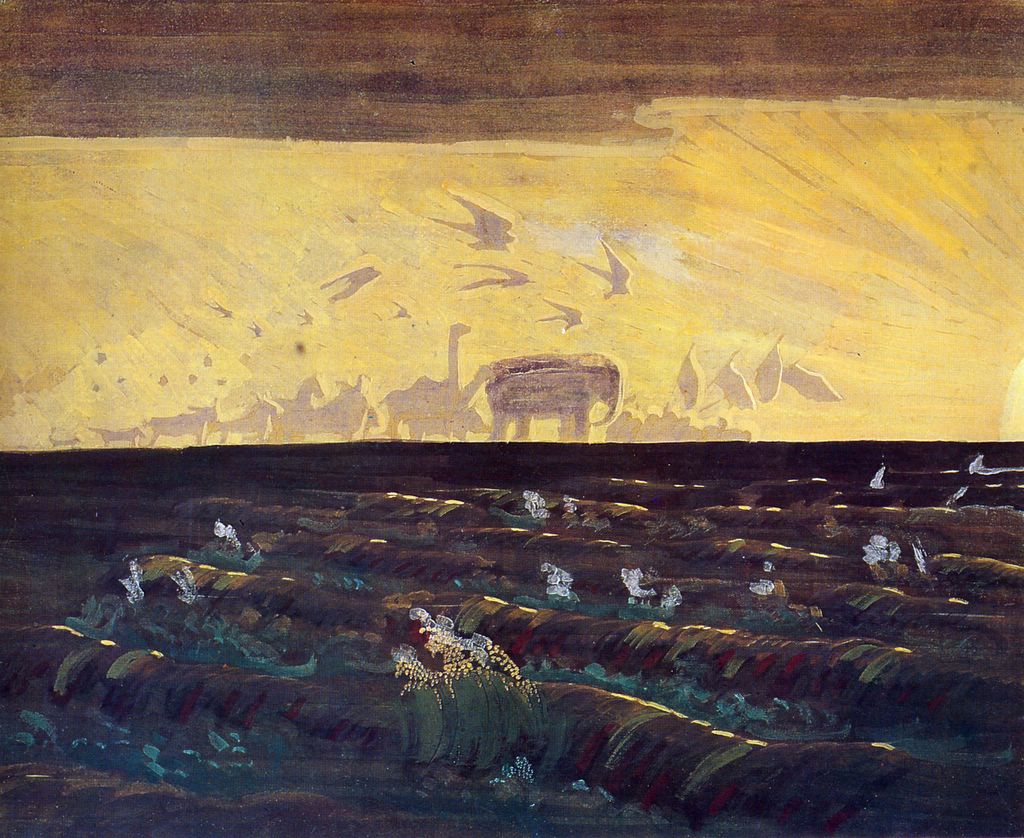Mikalojus Konstantinas Čiurlionis
M. K. Čiurlionis was an extremely talented turn-of-the-century painter and composer. He is still considered to have been the greatest artist and one of the best composers in the country to date. His art is symbolical, transcendental, sometimes abstract and often weird and wonderful in the extreme. Take his 1909 piece ‘Rex’, depicting a sort of polytheistic deity combining every worldly religion in his dominion over the earth and the universe.
Perhaps one of the best-known painters of symbolism, and considered one of the pioneers of abstract art in Europe, Mikalojus Konstantinas Čiurlionis (1875–1911) was a true art powerhouse, expanding his talent to music, and as the world found out later, photography.
Some even believe his letters to be excellent examples of creative writing. Productivity was always on his side too, with around 300 paintings and almost 400 musical pieces created over his short existence.
Born in Varėna, a town in the south of Lithuania, he was able to play by ear at age three, and sight-read music by age seven. Čiurlionis relocated to Warsaw, Poland to study piano and composition among other things, and then went on to sharpen his tools solely as a composer in Leipzig, Austria. He returned to Warsaw to study painting, and later organised a personal exhibition in St Petersburg. Čiurlionis passed away being only 35 – he never saw his daughter Danutė, who was raised by his wife Sofija Kymantaitė-Čiurlionienė, an art critic.
The 2420 Čiurlionis asteroid, identified in 1975, honors his achievements.

Balys Sruoga
Balys Sruoga is one of the most famous and influential Lithuanian writers of the 20th century.
Early life
He contributed to cultural journals from his early youth. His works were published by the liberal wing of the Lithuanian cultural movement, and also in various Lithuanian newspapers and other outlets (such as Aušrinė , Rygos naujienos etc.). In 1914 he began studying literature inSt. Petersburg, Russia, and later in Moscow, due to World War I and the Russian Revolution. In 1921 he enrolled in the University of Munich, where in 1924 he received his Ph.D for a doctoral thesis on Lithuanian folklore.
After returning to Lithuania, Sruoga taught at the University of Lithuania, and established a theater seminar that eventually became a course of study. He also wrote various articles on literature. From 1930 he began writing dramas, first Milžino paunksmė , later Radvila Perkūnas ,Baisioji naktis and Aitvaras teisėjas . In 1939 he began teaching at Vilnius University.
Nazi captivity
The Forest of the Gods
Sruoga’s best known work is the novel The Forest of the Gods ( Dievų miškas ), based on his own life experiences as a prisoner in Stutthof concentration camp in Sztutowo, Free City of Danzig now present-day Nowy Dwór Gdański County, Pomeranian Voivodeship, Poland, where he was sent in March 1943 together with forty-seven other Lithuanian intellectuals after the Nazis started a campaign against possible anti-Nazi agitation in occupied Lithuania.
In the book, Sruoga revealed life in a concentration camp through the eyes of a man whose only way to save his life and maintain his dignity was to view everything through a veil of irony and humor, where torturers and their victims are exposed as imperfect human beings, being far removed from the false ideals of their political leaders. For example, he wrote ” A man is not a machine. He gets tired. “, referring to the guards beating prisoners.
Originally the novel was suppressed by the Soviet officials; it was ultimately published in 1957, ten years after the author’s death.
In 2005 a movie with the same titled as the book was released. The film “The Forest of the Gods” became the most profitable film released after Lithuania gained independence. [2]
Later life
After the Soviets recaptured the Nazi camps, Sruoga continued to be held in the same camp. However, in 1945, he returned to Vilnius and continued teaching at Vilnius University, where he wrote the dramas Pajūrio kurortas and Barbora Radvilaitė .
The authorities’ refusal to publish The Forest of Gods and weak health resulting from his time in concentration camps led to his death in October 16, 1947. [3] The 2005 film Forest of the Gods was based on the book. The Forest of the Gods Youtube movie is here.

Vydūnas
[One who wishes everyone everything good]
“Vydūnas” was the pen-name name of Wilhelm Strorost. He was a Prussian-Lithuanian poet, humanist, philosopher, writer, a leader of the Prussian-Lithuanian national movement in Lithuania Minor, and one of the leaders of the theosophical movement in East Prussia.
He is best known for his philosophical writings which are very much inspired by the theosophical teaching combining religion, philosophy and science.
He is an important figure in the Lithuanian national movement, since one of the main goals of Vydūnas‘s philosophy was to understand what constitutes a nation and how a nation can survive during times of war and occupation.
Storost (Vydūnas) was educated as teacher at the Präparandenanstalt in Pillkallen (1883–85) and at teacher seminar in Ragnit (1885–88). From 1888 to 1892 he was a teacher in Kinten (lit. Kintai), when he went to teach at a boys school in Tilsit until 1912 and taught German, French, English, Lithuanian and sports.
In 1912 he left his teaching position in order to take up philosophical studies, which he took at the universities of Greifswald, Halle, Leipzig and Berlin. 1918/19 he taught Lithuanian at the Seminar for Oriental Languages in Berlin under the director Eduard Sachau.
Back in Tilsit he dedicated himself to reestablishment of Lithuanian Culture, especially folks songs and rural traditions. He directed a choir and wrote songs as well as theater plays. From 1933 on he worked in Memel at the music school.
1932 he wrote a book Sieben Hundert Jahren Deutsch-Litauischer Beziehung (Seven Hundred Years of German-Lithuanian relations). His idea of understanding between folks groups did not please the Nazis and in 1933 the book was outlawed. 1938 he was shortly incarcerated, but because of protests released after two months.
Together with nearly all of the people of East Prussia he was expelled during Communist take-over and lived in a refugee camp for some time. He died in Detmold, West Germany. His grand nephews, Jürgen Storost, recently explained, that Wilhelm Storost’s answered his friend Viktor Falkenhahn, that “his use of the pen name Vydunas was his chosen anthroposophic mission; that he did not want to be a “pavydūnas”, but a “vydūnas” (one who wishes everyone everything good).
Vydūnas was active in the old Lithuanian pagan religion (see Romuva). However, he never declared the revival of the pagan religion as either his personal goal or a goal of Lithuanians, remaining a national leader but not a religious one. His moral influence transcended the confines of being a typical political leader or a writer at his time. He was compared by later biographers with national leaders in India of his time, such as Rabindranath Tagore or Mahatma Gandhi. Pantheistic universalism, not predefined with participating in any obligatory religious practice, was one of the leading ideas of his philosophy, and gained him later fame as a pioneer of both pagan revival and theosophy in Lithuania.
Vydūnas was an ethical vegetarian, and wrote several essays about his ethical choices.
Vydūnas was considered a candidate for the Nobel Prize for Literature by the Lithuanian writers association.

Adam Mickiewicz
Polish | Lithuanian | Belarusian – there was a verbal war fought over him
Mickiewicz is an important figure for both Lithuanian and Polish cultures. He was the principal character in the Lithuanian and Polish Romantic movement. The writer is known chiefly for his poetic drama Dziady (“Forefathers’ Eve” in English), which has been likened to Goethe’s Faust and Byron’s Manfred, along with the nationalistic epic poem Pan Tadeusz.
He was passionate about national and personal freedom, opposed to the serfdom system and the Russian Tsarist regime. All of these values and beliefs are reflected in the poet’s works which are not only beautifully written but also ideologically strong and persuasive; all of which are most revered a little to the west, in Poland.
Mickiewicz was born in the Russian-partitioned territories of the former Grand Duchy of Lithuania, which had been part of the Polish-Lithuanian Commonwealth, and was active in the struggle to win independence for his home region. After, as a consequence, spending five years exiled to central Russia, in 1829 he succeeded in leaving the Russian Empire and, like many of his compatriots, lived out the rest of his life abroad. He settled first in Rome, then in Paris, where for a little over three years he lectured on Slavic literature at the Collège de France. He died, probably of cholera, at Constantinople in the Ottoman Empire, where he had gone to help organize Polish and Jewish forces to fight Russia in the Crimean War.
In 1890, his remains were repatriated from Montmorency, Val-d’Oise, in France, to Wawel Cathedral in Kraków, Poland.


Juozas Zikaras
Patriotic sculptor
Zikaras was one of the first Lithuanian professional sculptors. Having graduated from St Petersburg‘s Academy of Art, the sculptor came back to his homeland and produced a great amount of important sculptures that now decorate some important buildings in Lithuania, such as churches and museums.
Perhaps his most famous work is “Knygnešys“ (“The Smuggler of Books”) which stands in the garden of Kaunas’ War Museum. The sculpture depicts a Lithuanian phenomenon: book smugglers – people who, risking their lives and freedom, smuggled books into Lithuania from abroad in circumvention of the censorship of the Russian Empire.
He was born November 18, 1881 in the village of Paliūkai near Panevėžys in Lithuania (then part of the Russian Empire). Between 1904 and 1906 he studied fine arts at the Vilnius-based Lev Trutnev Drawing School, as well as classes given by Juozapas Montvila. Surpassing many of his fellow art students, Zikaras in 1907 went to St. Petersburg to continue his studies at the Drawing School of the Imperial Society for the Encouragement of the Arts. In 1910, after three years in St. Petersburg, he was accepted to the Imperial Academy of Arts, from where he graduated in 1915, already after the outbreak of World War I. Shortly before finishing his diploma work he was drafted into the Russian army. However, he was not dispatched to the front and instead was able to receive a silver award of his alma mater the following year. Demobilized, he remained in Russia and taught drawing at various schools to make a living.
In 1918 he returned to Panevėžys, where he started working in a secondary school and pedagogical seminary. In 1929 he moved to Kaunas, where he started heading the studio of sculpture at the Academy of Fine Arts. He held that post until the Soviet occupation of Lithuania in 1940. He continued to give classes of drawing during the German occupation and after the second Soviet occupation he was proposed a professor’s seat at the academy.
However he was accused by NKGB (the name of the Soviet secter police at the time) that his sons were with the “Forest Brothers“. He could not stand interrogations, and on November 10, 1944, he committed suicide at Kaunas.
He and his wife Anelė had four children, three sons and one daughter. The sons emigrated to the Western countries after World War II.
One, Teisutis, became an acclaimed sculptor in Melbourne, Australia.
The daughter, Alytė, remained in Lithuania and continued to live in her family’s house in Kaunas. Thanks to her efforts a lot of Zikaras’ works survived the Soviet occupation. In 1959 she established a small exhibition in her father’s workshop. Executing her will, the whole family house was turned into a museum in 2000. Another museum dedicated to Zikaras is located in the house where Zikaras spent his childhood. This house was turned into a museum in 1972.



“Ars”
“Ars” was an collective art group created in 1932 by four graduates of the Kaunas Art School: Antanas Gudaitis, Antanas Samuolis, Viktoras Vizgirda and Juozas Mikėnas.
What began as a single exhibition of avant-garde paintings and graphic works soon became a union of artists who were connected by their particular painting style.
Their art can be defined as a new and modern interpretation of Lithuanian folk art, all with a hint of Parisian styles (since many of the members have also studied in Parisian schools). The group was also the one to announce the first ever artists’ manifest in Lithuania, in 1932.
In 1932, painters Antanas Gudaitis, Antanas Samuolis, Viktoras Vizgirda and Juozas Mikėnas who graduated from Kaunas Art School organized an exhibition in which the artists Vytautas Kazimieras Jonynas, Telesfors Valius, Telesforas Kulakauskas and Jonas Steponavičius and older colleagues Mstislav Dobužinskis and Adam Galdikas participated.
In the exhibition, the artists published a statement that became the first manifesto of Lithuanian art. The creation of Ars members was united by the newly interpreted Lithuanian folk art and the style of the Parisian high schools of that time (all members of Ars, except for Samuolis and Kulakauskas, had recently studied or studied in Paris).
The group broke out in 1934, holding a second exhibition. 1935 Ars members joined the Lithuanian Artists’ Association, which was founded on the initiative of the members of the group.
Antanas Gudaitis was one of the most active “ARS” group organizers.
“Arsininkai” had rejected the canons obsolete, and created the artistic language that would allow unrestricted and free to express contemporary human aesthetic experiences, moods and worldview.
Manifesto
“[…] we are determined to serve this epoch of national revival and establish the artistic style of this epoch. A work of art is a new reality. We desire to enrich our lives with new values. […]”
The concepts of both newness and tradition were, however, problematic in the context of Lithuania’s national school. In search of reference points, young artists turned to Lithuanian folk art. Their choice had dual aims: to renounce naturalist portrayal using the principles of “naive” or “primitive” art and at the same time support experimentation within the fundament of tradition. Thus, the significance of folk art in Lithuania resembled the operation of primitivism in the work of the leading Western European modernists while differing from it. Folk art was perceived as not only an agent of modernisation, emancipation of imagination and breaking the old canons, but as a connection to Lithuanian cultural heritage.
The members of the Ars group also sought to adapt the Western modernist experience. All of them (excluding Samuolis and Kulakauskas) had recently completed their studies or were still studying in Paris. Though, the avant-garde movement was already ebbing in France’s capital. In the inter-bellum many Parisian artists were choosing the middle way, attempting to blend the viewpoints of the modernist and the classical aesthetics. What Lithuanians encountered in Paris was a brand of modernised tradition or halfway modernism, rather than radical, innovative challenge. This Parisian experience proved to be just as ambiguous as the domain of national culture that was shaping the attitudes of Kaunas’ artists.
The revolt of the Ars artists that shook Kaunas society was brief. Having organised their second exhibition in 1934, the group disbanded. In 1935, the members of Ars joined the Lithuanian Art Society, which united artists belonging to different generations and was founded on different initiatives, and turned towards traditional art. Even though the Ars group had not formulated a clear program, their theses and works, especially the expressionist paintings, had a lasting impact. They had set the benchmark for the blend of national originality and European modernity, which determined the development of Lithuanian art for decades to follow.
The group’s efforts to renew Lithuanian art weren’t isolated; though had the most impact. The efforts of other artists – for instance, Pranas Domšaitis, Eastern Prussia-born graduate of Königsberg [Kaliningrad] art academy – had a tangential relationship with Lithuania’s interwar culture. Domšaitis, who emigrated to Western Europe in 1910, spent most of his time in Berlin, where he joined the German expressionist movement. In the 1930s, the artist experienced the Nazi regime’s repressions: being a modernist, he was banned from participating in exhibitions, and his paintings were removed from Germany’s state museums.
Painter Vytautas Kairiūkštis, also shied from the trends dominating the art sphere of Kaunas; and never managed to fire the conservative public taste. In 1923, he organised the “Exhibition of New Art” in Vilnius together with Polish artist Władysław Strzemiński. This exhibition, which featured, among others, Warsaw artists Henryk Stażewski, Mieczysław Szczuka and Teresa Żarnowerówna, was one of the first manifestations of the Polish avant-garde. Both of its organisers, who had studied in Moscow, were influenced by Russian suprematism and constructivism and Western cubism. They cultivated abstract painting, experimenting with compositions comprised of geometric shapes and contrasting colours. In 1924, Strzemiński left Vilnius. Kairiūkštis, who was teaching at the Lithuanian Vytautas Magnus high school and supervised the art studio there, withdrew to the margin of local cultural life. Having repatriated to the Republic of Lithuania in 1932, he too shifted to work with the more moderate expressive means of Art Deco and postimpressionism.


Antanas Samuolis: Self portrait






